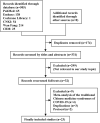Evidence Mapping of 23 Systematic Reviews of Traditional Chinese Medicine Combined With Western Medicine Approaches for COVID-19
- PMID: 35197851
- PMCID: PMC8860227
- DOI: 10.3389/fphar.2021.807491
Evidence Mapping of 23 Systematic Reviews of Traditional Chinese Medicine Combined With Western Medicine Approaches for COVID-19
Abstract
Background: Coronavirus disease 2019 (COVID-19) has already spread around the world. The modality of traditional Chinese medicine (TCM) combined with Western medicine (WM) approaches is being used to treat COVID-19 patients in China. Several systematic reviews (SRs) are available highlighting the efficacy and safety of TCM combined with WM approaches in COVID-19 patients. However, their evidence quality is not completely validated. Purpose: We aimed to assess the methodological quality and the risk of bias of the included SRs, assess the evidence quality of outcomes, and present their trends and gaps using the evidence mapping method. Methods: PubMed, Cochrane Library, Embase, CNKI, CBM, and Wanfang Data were searched from inception until March 2021 to identify SRs pertaining to the field of TCM combined with WM approaches for COVID-19. The methodological quality of the SRs was assessed using the Assessment of Multiple Systematic Reviews 2 (AMSTAR 2), the risk of bias of the included SRs was assessed with the Risk of Bias in Systematic Review (ROBIS) tool, and the evidence quality of outcomes was assessed using the Grading of Recommendations Assessment, Development and Evaluation (GRADE) system. Results: In total, 23 SRs were found eligible. Twenty-one were rated of moderate confidence by AMSTAR 2, while 12 were rated at low risk using the ROBIS tool. In addition, most outcomes were graded as having moderate quality using the GRADE system. We found that the combined use of TCM and WM approaches could improve the CT recovery rate, effective rate, viral nucleic acid negative conversion rate, and the disappearance rate of fever, cough, and shortness of breath. Also, these approaches could decrease the conversion rate from mild to critical, white blood cell counts, and lymphocyte counts and shorten the time to viral assay conversion and the length of hospital stay. Conclusion: TCM combined with WM approaches had advantages in efficacy, laboratory, and clinical symptom outcomes of COVID-19, but the methodological deficiencies of SRs should be taken into consideration. Therefore, to better guide clinical practice in the future, the methodological quality of SRs should still be improved, and high-quality randomized controlled trials (RCTs) and observational studies should also be carried out.
Keywords: AMSTAR 2; COVID-19; ROBIS; evidence mapping; grade; systematic reviews; traditional Chinese medicine combined with Western medicine approaches.
Copyright © 2022 Zhang, Li, Chen, Zhao, Tian and Zhang.
Conflict of interest statement
The authors declare that the research was conducted in the absence of any commercial or financial relationships that could be construed as a potential conflict of interest.
Figures






Similar articles
-
Efficacy and safety of traditional Chinese medicine adjuvant therapy for severe pneumonia: evidence mapping of the randomized controlled trials, systematic reviews, and meta-analyses.Front Pharmacol. 2023 Sep 29;14:1227436. doi: 10.3389/fphar.2023.1227436. eCollection 2023. Front Pharmacol. 2023. PMID: 37841930 Free PMC article.
-
Traditional Chinese medicine treatment for COVID-19: An overview of systematic reviews and meta-analyses.J Integr Med. 2022 Sep;20(5):416-426. doi: 10.1016/j.joim.2022.06.006. Epub 2022 Jun 24. J Integr Med. 2022. PMID: 35811240 Free PMC article. Review.
-
Effectiveness and Safety of Acupuncture for Migraine: An Overview of Systematic Reviews.Pain Res Manag. 2020 Mar 23;2020:3825617. doi: 10.1155/2020/3825617. eCollection 2020. Pain Res Manag. 2020. PMID: 32269669 Free PMC article. Review.
-
Chinese herbal medicine xuebijing injection for acute pancreatitis: An overview of systematic reviews.Front Pharmacol. 2022 Aug 10;13:883729. doi: 10.3389/fphar.2022.883729. eCollection 2022. Front Pharmacol. 2022. PMID: 36034818 Free PMC article.
-
Benefits and Safety of Chinese Herbal Medicine in Treating Psoriasis: An Overview of Systematic Reviews.Front Pharmacol. 2021 Jul 1;12:680172. doi: 10.3389/fphar.2021.680172. eCollection 2021. Front Pharmacol. 2021. PMID: 34276371 Free PMC article.
Cited by
-
The Chinese herb Styrax triggers pharmacokinetic herb-drug interactions via inhibiting intestinal CYP3A.Front Pharmacol. 2022 Aug 29;13:974578. doi: 10.3389/fphar.2022.974578. eCollection 2022. Front Pharmacol. 2022. PMID: 36110541 Free PMC article.
-
Characteristics and result reporting of registered COVID-19 clinical trials of Chinese and Indian traditional medicine: A comparative analysis.Front Med (Lausanne). 2023 Feb 17;10:1118269. doi: 10.3389/fmed.2023.1118269. eCollection 2023. Front Med (Lausanne). 2023. PMID: 36873866 Free PMC article.
-
An artificial intelligence-aided scoping review of medicinal plant research in the Fertile Crescent.Front Pharmacol. 2025 Jun 3;16:1542709. doi: 10.3389/fphar.2025.1542709. eCollection 2025. Front Pharmacol. 2025. PMID: 40529497 Free PMC article. Review.
-
Practices, Knowledge, and Attitudes of Chinese University Students Toward Traditional Chinese Herbal Medicine for the Control of COVID-19.Infect Drug Resist. 2022 Nov 30;15:6951-6962. doi: 10.2147/IDR.S387292. eCollection 2022. Infect Drug Resist. 2022. PMID: 36474905 Free PMC article.
-
Clinical Evidence and Potential Mechanisms of Complementary Treatment of Ling Gui Zhu Gan Formula for the Management of Serum Lipids and Obesity.Evid Based Complement Alternat Med. 2022 May 9;2022:7714034. doi: 10.1155/2022/7714034. eCollection 2022. Evid Based Complement Alternat Med. 2022. PMID: 35586687 Free PMC article. Review.
References
-
- BBC News (2020). Worst Economic Crisis since 1930s Depression, IMF Says. Available at: https://www.bbc.com/news/business-52236936 (accessed April 20, 2021).
-
- Bougioukas K. I., Liakos A., Tsapas A., Ntzani E., Haidich A. B. (2018). Preferred Reporting Items for Overviews of Systematic Reviews Including Harms Checklist: A Pilot Tool to Be Used for Balanced Reporting of Benefits and Harms. J. Clin. Epidemiol. 93, 9–24. 10.1016/j.jclinepi.2017.10.002 - DOI - PubMed
-
- Cai X., Tang F., Ma W. K., Zhang S. Q. (2020). Meta-analysis of the Combination of Traditional Chinese and Western Medicine in the Treatment of COVID-19. J. Baotou. Med. Coll. 36, 95–98. 10.16833/j.cnki.Jbmc.2020.03.034 - DOI
Publication types
LinkOut - more resources
Full Text Sources

